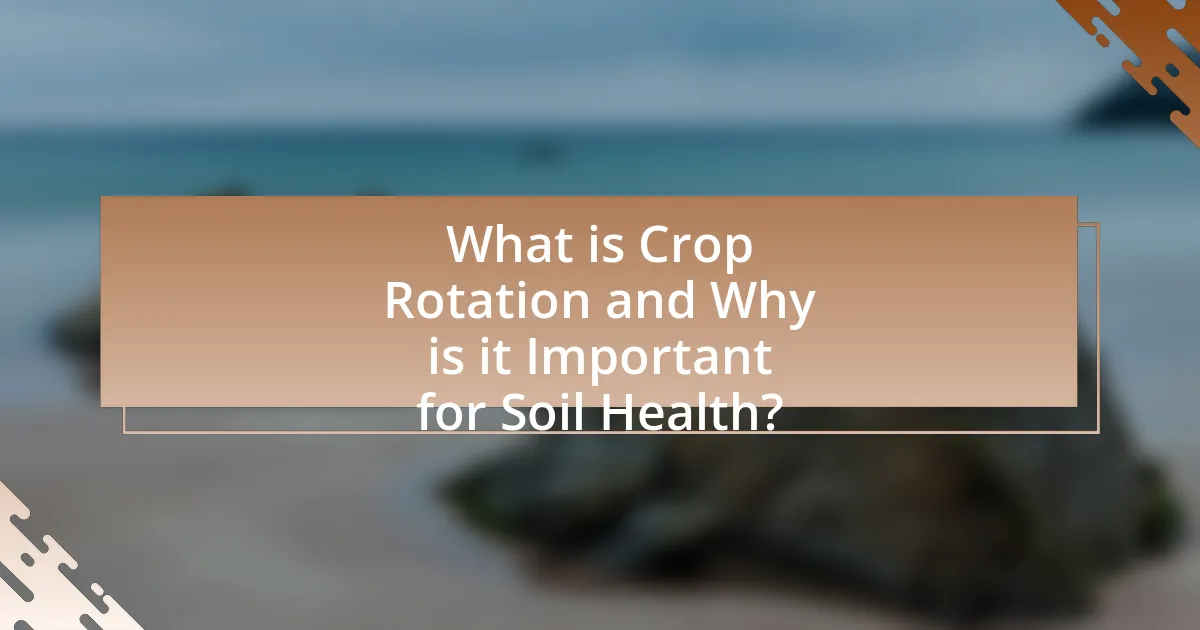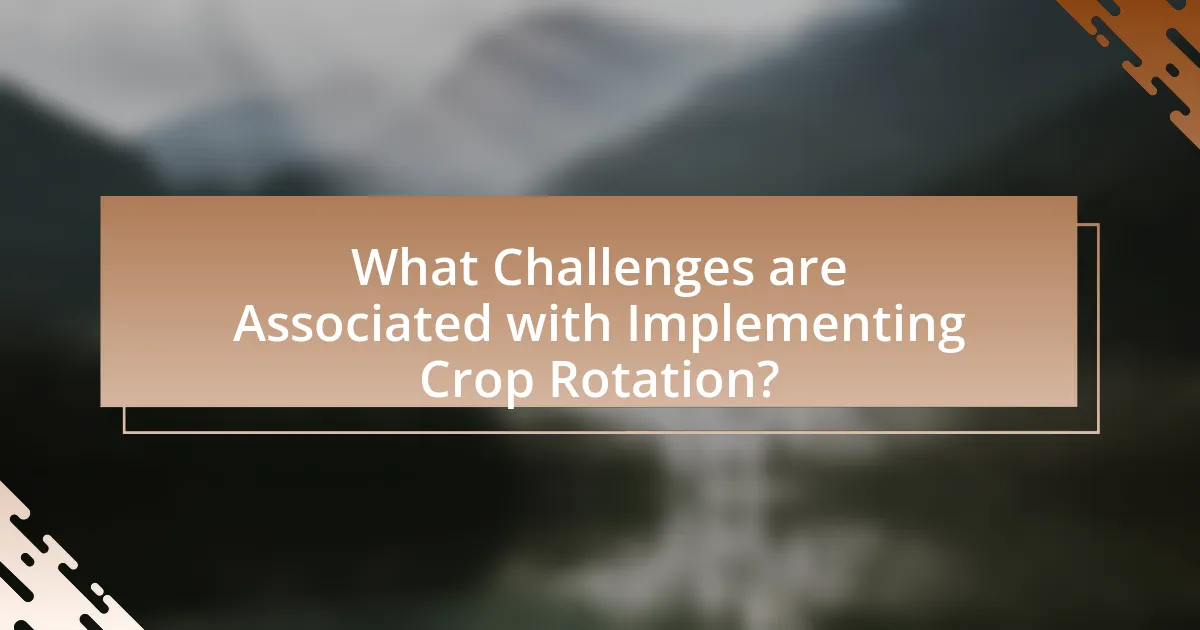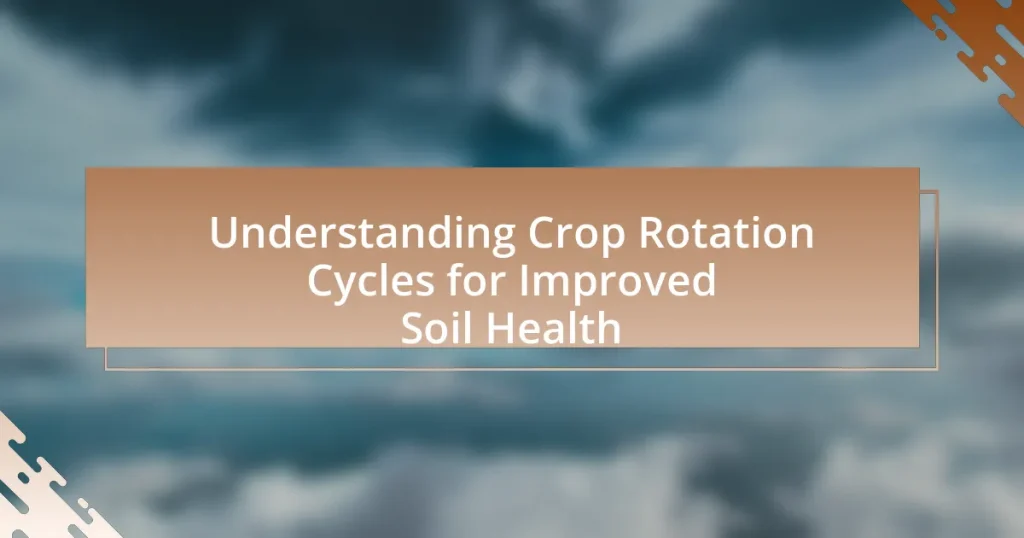Crop rotation is an agricultural practice that involves alternating different types of crops in a specific area over various seasons or years, significantly contributing to soil health. This method enhances soil fertility, reduces erosion, and disrupts pest and disease cycles, leading to increased crop yields by 10-20% compared to continuous cropping systems. The article explores the principles of crop rotation, its historical evolution, various systems, and the benefits of specific patterns, while also addressing challenges farmers face in implementation. Additionally, it highlights the role of technology and best practices for optimizing crop rotation to improve soil health and agricultural productivity.

What is Crop Rotation and Why is it Important for Soil Health?
Crop rotation is the agricultural practice of alternating the types of crops grown in a specific area across different seasons or years. This method is important for soil health because it enhances soil fertility, reduces soil erosion, and disrupts pest and disease cycles. For instance, rotating legumes with cereals can improve nitrogen levels in the soil, as legumes fix atmospheric nitrogen, benefiting subsequent crops. Research indicates that crop rotation can lead to a 10-20% increase in crop yields compared to continuous cropping systems, demonstrating its effectiveness in maintaining soil health and productivity.
How does crop rotation contribute to soil health?
Crop rotation enhances soil health by improving nutrient availability, reducing soil erosion, and promoting biodiversity. Different crops have varying nutrient requirements and root structures, which helps maintain soil fertility and structure. For instance, legumes, such as beans and peas, fix nitrogen in the soil, enriching it for subsequent crops. Research indicates that fields with diverse crop rotations can yield 10-20% more than those with monoculture practices, as reported in a study by the Rodale Institute. This practice also disrupts pest and disease cycles, leading to healthier soil ecosystems.
What are the key principles of crop rotation?
The key principles of crop rotation include alternating different types of crops in a specific sequence to enhance soil fertility, disrupt pest and disease cycles, and improve crop yields. This practice helps in maintaining soil health by preventing nutrient depletion, as different crops have varying nutrient requirements and contributions. For instance, legumes can fix nitrogen in the soil, benefiting subsequent crops. Research indicates that crop rotation can lead to a 10-20% increase in yield compared to continuous cropping systems, demonstrating its effectiveness in sustainable agriculture.
How does crop rotation affect soil nutrients?
Crop rotation enhances soil nutrients by promoting a diverse range of crops that contribute different nutrients to the soil. For instance, legumes, such as beans and peas, fix atmospheric nitrogen, enriching the soil with this essential nutrient, while other crops may deplete specific nutrients. Research indicates that rotating crops can lead to improved soil structure and increased organic matter, which further supports nutrient availability. A study published in the journal “Agronomy” by Drinkwater et al. (1998) demonstrated that crop rotation systems significantly increased soil fertility and reduced the need for chemical fertilizers, confirming the positive impact of diverse cropping practices on soil nutrient levels.
What are the historical practices of crop rotation?
Historical practices of crop rotation involve the systematic alternation of different crops in the same field across seasons or years to enhance soil fertility and control pests. Ancient civilizations, such as the Romans and Chinese, utilized crop rotation techniques, often alternating legumes with cereals to replenish nitrogen levels in the soil. For instance, the three-field system developed in medieval Europe involved rotating between winter grains, spring grains, and fallow land, which improved soil health and increased agricultural yields. These practices were validated by agronomic studies showing that crop diversity can lead to improved soil structure and reduced disease incidence, thereby supporting sustainable farming methods throughout history.
How have crop rotation methods evolved over time?
Crop rotation methods have evolved from simple practices in ancient agriculture to complex, scientifically-informed systems aimed at enhancing soil health and crop productivity. Initially, early farmers practiced basic rotation by alternating crops to prevent soil depletion, as evidenced by historical records from Mesopotamia and ancient Egypt. Over time, the introduction of legumes into rotation systems improved nitrogen fixation, which was documented in the 18th century by agricultural pioneers like Jethro Tull.
In the 20th century, advancements in agronomy led to more systematic approaches, incorporating principles of ecology and soil science. Research has shown that diverse crop rotations can significantly reduce pest and disease pressures, improve soil structure, and enhance nutrient cycling. For instance, studies have demonstrated that rotating corn with soybeans can increase yields by up to 20% compared to continuous cropping. Today, modern crop rotation practices are informed by data-driven methodologies, including precision agriculture techniques, which optimize crop selection based on soil health indicators and environmental conditions.
What lessons can be learned from traditional crop rotation practices?
Traditional crop rotation practices teach the importance of biodiversity and soil health management. By alternating different crops, farmers can enhance soil fertility, reduce pest and disease cycles, and improve overall crop yields. For instance, legumes, when rotated with cereals, fix nitrogen in the soil, which benefits subsequent crops. Historical evidence shows that ancient civilizations, such as the Romans and Chinese, utilized crop rotation to sustain agricultural productivity over centuries, demonstrating its effectiveness in maintaining soil health and preventing nutrient depletion.

What are the Different Types of Crop Rotation Systems?
The different types of crop rotation systems include simple rotation, complex rotation, and cover cropping systems. Simple rotation involves alternating two or more crops in a specific sequence, which helps in managing soil fertility and pest control. Complex rotation incorporates a wider variety of crops over a longer period, enhancing biodiversity and soil health. Cover cropping systems involve planting cover crops during off-seasons to prevent soil erosion, improve soil structure, and enhance nutrient cycling. These systems are validated by agricultural studies showing improved yields and reduced soil degradation when diverse crop rotations are implemented.
How do different crop rotation systems impact soil health?
Different crop rotation systems significantly enhance soil health by improving nutrient availability, reducing soil erosion, and promoting biodiversity. For instance, rotating legumes with cereals can increase nitrogen levels in the soil, as legumes fix atmospheric nitrogen, which benefits subsequent crops. Research indicates that diverse crop rotations can lead to a 20-30% increase in soil organic matter compared to monoculture systems, which enhances soil structure and water retention. Additionally, crop rotation disrupts pest and disease cycles, reducing the need for chemical inputs and fostering a more resilient soil ecosystem. Studies have shown that farms employing varied crop rotations experience improved soil microbial diversity, which is crucial for nutrient cycling and overall soil vitality.
What is the difference between simple and complex crop rotation systems?
Simple crop rotation systems involve alternating two or three different crops in a specific sequence over time, while complex crop rotation systems incorporate a wider variety of crops, often including legumes, cover crops, and multiple species in a more intricate pattern. Simple systems typically focus on reducing pest and disease pressure and improving soil fertility through basic crop diversity, whereas complex systems enhance soil health more significantly by promoting biodiversity, improving nutrient cycling, and increasing resilience against environmental stressors. Research indicates that complex rotations can lead to higher yields and better soil structure compared to simple rotations, as demonstrated in studies by the USDA Agricultural Research Service, which found that diverse cropping systems improve soil organic matter and microbial activity.
How does intercropping fit into crop rotation practices?
Intercropping enhances crop rotation practices by diversifying plant species grown together, which improves soil health and reduces pest pressure. This method allows for complementary interactions between crops, such as nitrogen-fixing legumes paired with nutrient-demanding cereals, leading to better nutrient utilization. Research indicates that intercropping can increase overall yield by up to 20% compared to monoculture systems, as shown in studies conducted by the Food and Agriculture Organization. Additionally, intercropping contributes to soil structure and organic matter, further supporting sustainable agricultural practices.
What are the benefits of specific crop rotation patterns?
Specific crop rotation patterns enhance soil health by improving nutrient availability, reducing pest and disease pressure, and increasing biodiversity. For instance, rotating legumes with cereals can fix nitrogen in the soil, enriching it for subsequent crops. Research indicates that diverse crop rotations can lead to a 10-20% increase in crop yields compared to monoculture systems, as demonstrated in studies by the Rodale Institute. Additionally, specific rotations can disrupt pest life cycles, leading to lower pesticide use and healthier ecosystems.
Which crops are best suited for rotation with legumes?
Crops best suited for rotation with legumes include cereals such as corn, wheat, and barley, as well as root crops like potatoes and carrots. These crops benefit from the nitrogen-fixing ability of legumes, which enhances soil fertility. Research indicates that rotating legumes with these crops can lead to improved yields; for instance, studies show that corn following legumes can yield up to 20% more due to increased nitrogen availability in the soil.
How can crop rotation help in pest and disease management?
Crop rotation helps in pest and disease management by disrupting the life cycles of pests and pathogens. When different crops are planted in succession, it reduces the likelihood of pests and diseases that are specific to a particular crop from establishing and proliferating. For example, rotating crops such as legumes with cereals can break the cycle of pests like root maggots and diseases like Fusarium wilt, which thrive on specific host plants. Research has shown that crop rotation can lead to a significant decrease in pest populations and disease incidence, enhancing overall crop health and yield.

What Challenges are Associated with Implementing Crop Rotation?
Implementing crop rotation faces several challenges, including the need for careful planning, knowledge of crop compatibility, and potential economic implications. Farmers must meticulously plan their crop sequences to ensure that each crop benefits from the previous one while minimizing pest and disease cycles. Additionally, understanding which crops are compatible and how they interact with soil nutrients is crucial; for instance, legumes can enhance soil nitrogen levels, but improper sequencing can lead to nutrient depletion. Economic factors also play a significant role, as farmers may incur costs related to changing equipment or practices, and there may be a risk of reduced yields in the transition period. These challenges highlight the complexity of effectively implementing crop rotation for improved soil health.
What are the common obstacles farmers face with crop rotation?
Farmers commonly face several obstacles with crop rotation, including limited knowledge of effective rotation strategies, financial constraints, and pest management challenges. Limited knowledge can hinder farmers from selecting the most beneficial crop sequences that enhance soil health and productivity. Financial constraints often arise from the costs associated with implementing new crops and practices, which can deter farmers from adopting crop rotation. Additionally, managing pests and diseases can become complicated when changing crops, as some pests may thrive on specific plants, leading to increased management efforts and costs. These obstacles can significantly impact the successful implementation of crop rotation practices.
How can economic factors influence crop rotation decisions?
Economic factors significantly influence crop rotation decisions by determining the profitability and sustainability of different crops. Farmers assess market prices, input costs, and potential yields when selecting which crops to rotate. For instance, if the market price for soybeans is high, a farmer may choose to plant soybeans in rotation with corn to maximize profits. Additionally, the cost of fertilizers and pesticides can impact crop choices; lower input costs may encourage the rotation of more diverse crops that improve soil health, while higher costs may lead to a focus on fewer, more profitable crops. Historical data shows that regions with fluctuating commodity prices often see shifts in crop rotation practices, as farmers adapt to economic pressures to maintain profitability and soil health.
What role does climate play in the effectiveness of crop rotation?
Climate significantly influences the effectiveness of crop rotation by affecting soil moisture, temperature, and the prevalence of pests and diseases. For instance, warmer climates can accelerate crop growth but may also increase the risk of drought, impacting the success of certain crops in rotation. Additionally, specific climatic conditions can favor the development of pests that target particular crops, thereby influencing the choice of rotation to mitigate these risks. Research indicates that regions with diverse climates can benefit from tailored crop rotation strategies that align with local weather patterns, enhancing soil health and productivity.
How can farmers overcome challenges in crop rotation?
Farmers can overcome challenges in crop rotation by implementing diverse planting schedules and selecting complementary crops. This approach enhances soil health, reduces pest and disease cycles, and improves nutrient availability. Research indicates that rotating crops such as legumes with cereals can increase soil nitrogen levels, benefiting subsequent crops. Additionally, utilizing cover crops during off-seasons can prevent soil erosion and suppress weeds, further supporting sustainable farming practices.
What strategies can be employed to ensure successful crop rotation?
To ensure successful crop rotation, farmers should implement a diverse planting schedule that includes a variety of crops, such as legumes, grains, and root vegetables. This diversity helps break pest and disease cycles, enhances soil fertility, and improves overall crop yields. Research indicates that rotating crops can reduce the need for chemical fertilizers and pesticides, as different plants contribute various nutrients to the soil and can suppress weeds. For instance, legumes fix nitrogen in the soil, benefiting subsequent crops. Additionally, maintaining a rotation plan that considers crop families and their nutrient requirements can optimize soil health and productivity.
How can technology assist in optimizing crop rotation practices?
Technology can assist in optimizing crop rotation practices by utilizing data analytics, precision agriculture tools, and remote sensing technologies. Data analytics enables farmers to analyze soil health, weather patterns, and crop performance, allowing for informed decisions on which crops to plant in succession. Precision agriculture tools, such as GPS and soil sensors, provide real-time data on soil conditions, helping farmers tailor their crop rotation strategies to enhance nutrient availability and reduce pest pressures. Remote sensing technologies, including satellite imagery, allow for monitoring crop health and growth patterns over large areas, facilitating timely adjustments to rotation plans. Studies have shown that integrating these technologies can lead to increased yields and improved soil health, demonstrating their effectiveness in optimizing crop rotation practices.
What are the best practices for implementing effective crop rotation?
The best practices for implementing effective crop rotation include selecting diverse crops, planning rotations based on crop families, and incorporating cover crops. Diverse crops help break pest and disease cycles, while rotating among different plant families reduces nutrient depletion and enhances soil health. For instance, rotating legumes with cereals can improve nitrogen levels in the soil, as legumes fix atmospheric nitrogen. Additionally, incorporating cover crops during off-seasons can prevent soil erosion and improve organic matter content. Research indicates that farms practicing effective crop rotation can increase yields by up to 20% compared to monoculture systems, demonstrating the significant benefits of these practices for soil health and agricultural productivity.
How can farmers assess their soil health before starting crop rotation?
Farmers can assess their soil health before starting crop rotation by conducting soil tests to analyze nutrient levels, pH, organic matter content, and microbial activity. Soil testing provides quantitative data that helps farmers understand the current condition of their soil, which is essential for making informed decisions about crop selection and rotation strategies. Research indicates that soil tests can reveal deficiencies or excesses in nutrients, allowing farmers to amend their soil accordingly, thus enhancing crop productivity and sustainability.
What resources are available for farmers to learn about crop rotation?
Farmers can access various resources to learn about crop rotation, including agricultural extension services, online courses, and research publications. Agricultural extension services, provided by universities and government agencies, offer workshops and one-on-one consultations to educate farmers on effective crop rotation practices. Online platforms like eXtension.org provide comprehensive guides and articles on crop rotation strategies. Additionally, research publications from institutions such as the USDA and universities present scientific findings and case studies that demonstrate the benefits of crop rotation for soil health and productivity. These resources collectively support farmers in implementing successful crop rotation systems.










